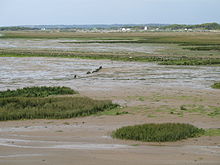Raw march

The raw march (outdated: salt marsh ) is a type of soil that forms the transition stage between the mudflats and the marsh . It is periodically flooded and shows the beginning of soil formation. In the German Soil Systematics , it is assigned to class M (marshes) in the department of semi-terrestrial soils . The abbreviation of the soil type is MR. In the international soil classification World Reference Base for Soil Resources (WRB), the raw marshes belong to the Gleysols .
Origin and Distribution
As soon as a mudflat is no longer flooded by the tides on a daily basis , soil development begins. Vegetable vegetation ( samphire ) forms, which becomes more and more intense as the periods of flooding decrease, so that salt marshes are formed. In Germany, raw marshes can be found along the North Sea coast, with the transition area between the tidal flats and marshes largely in front of the dykes ( dyke foreland ).
Leveling and characteristics
The standard leveling of the raw march is zAh / zGo / zGr.
- Ah: The vegetation quickly creates a humus (h) topsoil horizon (A). The topsoil is partly influenced by the groundwater due to the low altitude above sea level, so that the horizon has Go properties.
- Go: While there is a lack of oxygen at a depth of just a few millimeters in the mud flats due to high microbiological turnover rates and two daily floods, the subsoil of the raw march is somewhat better ventilated. This supplies the uppermost area of the subsoil horizon (G) influenced by the groundwater with oxygen. Aerobic conditions prevail , which means that the redox potential of the soil is oxidizing (o). The intensely black iron sulfide (FeS) formed in the tidal flats under lack of oxygen is oxidized, which causes the color of the zGo horizon to change from black to brown-orange ( sulfur dynamics of the marshes ). The depth of oxygen supply is not yet very powerful.
- Gr: The oxygen supply to the groundwater-affected subsoil (G) ends at the level of the mean tidal flood . In deeper areas the oxygen is missing again ( anaerobic ), so that the redox potential is reducing (r). The iron sulfide is retained and the soil is intensely black. During the raw march, the Gr horizon must begin in the top 40 cm of the ground. If it is lower, it is a different type of marsh soil such as B. the Kalkmarsch following the raw march . Many plants of the salt marsh, such as the samphire, can actively transport atmospheric oxygen into their root space ( aerenchyma ), which is why their roots can also grow into the oxygen-free Gr horizon. In the green, therefore, oxidative zones with a brown-orange color develop along the roots.
- The z stands for the salinity of the soil, which is due to the constant influence of sea water and the spray of the surf. Very strong fluctuations over the course of the year are typical. The salt content is particularly high after floods or in dry seasons, when the low sea water is drawn upwards due to the high evaporation rate on the surface ( ascendant displacement ). It is low after long periods of time without flooding or after heavy salt washout due to intense rain events. Only specially adapted plants can grow under these conditions.
In addition to desalination, other processes also occur, such as structure formation and sagging.
use
In the past, these areas were systematically diked in order to reclaim land . This is no longer practiced, however, since the dykes have only had a coastal protection function since the second half of the 20th century . The reason for this step can be seen in the establishment of the national parks in the Wadden Sea .
Today the raw march has the following functions:
- Protection: The foreland is important for the safety of the dykes, because the surf from the storm tides loses a large part of its force on it, so that the damage to the dyke is mitigated.
- Nature conservation: The natural vegetation of the raw marshes is the salt marsh . This is an important habitat for many animals.
- Use: Traditionally, the dike foreland is used as pasture for sheep. Grazing is mainly carried out in the areas directly in front of the dike, whereby the sheep also have coastal protection functions by keeping the grass short. There were and still are differences of opinion between sheep farmers and nature conservationists about the intensity and area of pasture use.
Web links
- Soil type raw march on www.ahabc.de : The magazine for soil and garden
literature
- Ad Hoc Working Group Soil (2005): Soil Science Mapping Instructions, 5th Edition, ISBN 3-510-95920-5
- W. Amelung, H.-P. Blume , H. Fleige, R. Horn, E. Kandeler , I. Kögel-Knabner , R. Kretschmar, K. Stahr , B.-M. Wilke: Scheffer / Schachtschabel textbook of soil science. 17th edition. Heidelberg 2018. ISBN 978-3-662-55870-6 .